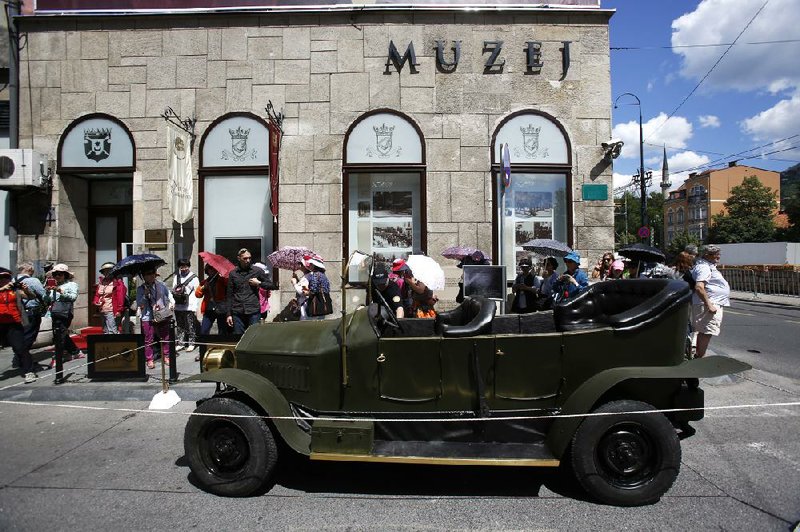SARAJEVO, Bosnia-Herzegovina -- Marking the eve of the centennial of the beginning of World War I in their own way, Bosnian Serbs on Friday unveiled a monument in their part of Sarajevo to the man who ignited the war by assassinating the Austro-Hungarian crown prince June 28, 1914.
At the other end of the city, the Vienna Philharmonic orchestra was rehearsing for Saturday's European Union-sponsored performance, planned as a symbolic start of a new century of peace at the place where the century of wars in Europe started 100 years ago.
The two separate events testify to the depth of lingering divisions in Bosnia-Herzegovina, where one side performed works of Austrian, German and French composers in a salute to European integration while the other celebrated the man who assassinated the emperor's heir as a national hero.
Saturday's concert aims to emphasize the transformation Europe has gone through, said Clemens Hellsberg, the president of the Vienna Philharmonic Orchestra. "We feel obliged to do things in a better way than it was done in the past," the Austrian said, adding the orchestra is delivering a message of humanity to those who want to listen.
It will start with the Bosnian anthem and finish with Beethoven's "Ode to Joy" -- the official European anthem -- which symbolizes where Europe sees Bosnia's future, he said.
In the Bosnian Serb East Sarajevo, they have a different view of Bosnia's future: to divide the country so the Serb part can join neighboring Serbia.
During the unveiling ceremony Friday, a young actor dressed as shooter Gavrilo Princip ran on the stage and fired two shots in the air. He then cited a poem Princip wrote in captivity, which was followed by a Serbian folk dance. Later, the actor pointed his gun into the air while posing in front of Princip's statue as people in the crowd shouted he should "shoot at NATO" or "shoot at the EU."
"Gavrilo Princip was a freedom fighter, and the Austro-Hungarian empire was an occupier here," said the president of the Bosnian Serb half of the country, Milorad Dodik, after he unveiled the bronze statue.
"People who live here have never been on the same side of history and are still divided. We are sending different messages, and that says it all about this country, which is being held together by international violence," he said.
A century ago, Austria accused Serbia of masterminding the assassination and attacked the country with backing from Germany. Serbia's allies, Russia and France, were quickly drawn in and later Britain, its sprawling Commonwealth empire and the United States also joined the fighting. When the mass slaughter known as the Great War ended in 1918, it had claimed some 14 million lives.
For the Bosnian Serbs, Princip's shots on St. Vitus Day -- a sacred Serb holiday of June 28 -- announced the liberation from Austro-Hungarian rule and a chance for including Bosnia into the neighboring Serbian kingdom. That same idea inspired the Serbs in 1992 to fight the decision by Muslim Bosnians and Catholic Croats to declare the former republic of Bosnia independent when Serb-dominated Yugoslavia fell apart.
A peace agreement ended the 1992-95 war without a winner by recognizing Bosnia as a sovereign state but divided in two parts -- one for the Serbs and the other shared by Muslim Bosniaks and Roman Catholic Croats. The Serb leadership sees the current division only as a step toward a final dissolution and inclusion of their half into Serbia.
"St. Vitus day is an inspiration for all of us," said Nebojsa Radmanovic, the Serb member of Bosnia's joint three-member presidency. "It's an inspiration in the fight for our freedom, in a fight for our sacrifice and in our joint battle for a joint country, which we haven't managed yet to create," he said referring to a Greater Serbia.
Serbs refused to take part in the commemoration in Sarajevo on Saturday, where the EU has financed various international cultural events to mark the centennial.
"Sarajevo is now a symbol of a century of wars in Europe, but we are here to talk about peace and reconciliation," said Joseph Zimet, Sarajevo director general of the "Mission du centenaire" -- a French-led partnership program managing the WWI commemorations. He added that it "was a pity" Serbs from Serbia and Bosnia have "not joined us."
Sarajevo Mayor Ivo Komsic said those who refused to come "demonstrated not their attitude toward the past but toward the future of this region."
Maestro Franz Welser-Most said the Vienna Philharmonic Orchestra came to Sarajevo "with a historical burden" and with the intention to "send a clear message: Never again!"
A Section on 06/28/2014

